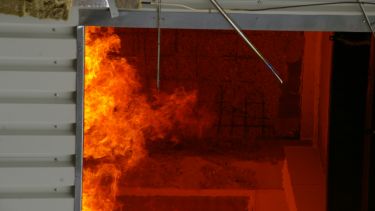Big infrastructure, such as tunnels, railways and buildings, are often built from large concrete structures. If they are subject to a fire, these structures heat up, causing the moisture in the concrete to evaporate.
However, the steam cannot easily escape from the concrete and pressure builds up. The concrete structure eventually explodes on its surface (spalling), cracks develop, and water vapour is often seen seeping out.
To prevent these explosions we can put polymer fibres extracted from recycled tyres into the concrete. In the event of a fire, these fibres melt and provide channels for the steam to escape from the concrete.
Possible collapse of structures is therefore avoided by reducing concrete damage and by preventing the fire from reaching the steel reinforcement.
As part of her 4th-year dissertation, Dawn Hou has built a physical concrete model to mimic the lining of a tunnel and applied a temperature to replicate the fire conditions; heating the concrete to 1000oC in 1 minute.
She tested samples with and without the fibres and found that the concrete without fibres spalled, whereas the concrete with fibres ‘cried’ as the water and vapour trapped
inside escaped.

